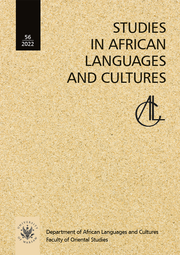Informacje o publikacji
| Wydanie: | 1 |
| Miejsce i rok wydania: | Warszawa 2022 |
| Język publikacji: | angielski |
| ISBN/ISSN: | 2657-4187 |
| Liczba stron: | 208 |
| Sposób publikacji: | PDF |
| Typ publikacji: | Praca naukowa , Open access |
Numer zawiera artykuły dotyczące cech strukturalnych języków afrykańskich i propozycji nowych ujęć teoretycznych w ich opisie. Zmiany samogłosek zachodzące w wyniku procesów morfofonologicznych w języku zulu interpretowane są przez pryzmat nietolerancji sąsiedztwa samogłosek, natomiast funkcjonowanie fraz nominalnych w strukturze zdania weryfikowane jest na przykładzie języka z klasami nominalnymi (Ikyaushi). Cechy strukturalne, które są charakterystyczne dla języków afrykańskich, znajdują odzwierciedlenie w morfologicznej analizie imion własnych w języku joruba, a ich cechy pragmatyczne pokazane są poprzez strategie udzielania negatywnych odpowiedzi bez posługiwania się sformułowaniami o konotacji negatywnej.
Afrykańskie konceptualizacje pojęć ilustrowane są przykładami figuratywnych rozszerzeń semantycznych terminu GŁOWA w języku Dholuo oraz eufemizmów dotyczących mówienia o śmierci w języku Nzema. Artykuły koncentrujące się na literaturze afrykańskiej zawierają analizę przenikania się formy, treści i stylu poezji tradycyjnej joruba oraz pieśni chrześcijańskich, a także zapis poematów tradycji ustnej w języku amharskim (wraz z tłumaczeniem i analizą językowo-literacką) z kolekcji Stefana Strelcyna.
Autorami artykułów są afrykaniści z ośrodków europejskich, amerykańskich i afrykańskich oraz Uniwersytetu Warszawskiego.
Publikacja na licencji Creative Commons Uznanie autorstwa-Na tych samych warunkach 4.0 Międzynarodowa PL (CC BY-SA 4.0 PL) (pełna treść wzorca dostępna pod adresem: https://creativecommons.org/licenses/by-sa/4.0/legalcode.pl).
*********
The issue contains articles on the structural features of African languages and proposals for new theoretical approaches in their description. Vowel changes occurring as a result of morphophonological processes in Zulu are interpreted through the prism of avoiding vowel adjacency, while the functioning of nominal phrases in sentence structure is verified on the example of a language with nominal classes (Ikyaushi). Structural features that are characteristic of African languages are reflected through the morphological analysis of proper names in Yoruba, and their pragmatic features are presented on the example of strategies for giving negative answers without using phrases with a negative connotation.
African conceptualizations of ideas are illustrated with examples of figurative semantic extensions of the term HEAD in the Dholuo language and euphemisms for talking about death in the Nzema language. Articles focusing on African literature include an analysis of the interweaving of form, content and style of Yoruba traditional poetry and Christian songs, as well as a transcript of oral tradition poems in Amharic (with translation and linguistic and literary analysis) from Stefan Strelcyn’s collection.
The authors of the articles are Africanists from European, American and African research centers and the University of Warsaw.
Afrykańskie konceptualizacje pojęć ilustrowane są przykładami figuratywnych rozszerzeń semantycznych terminu GŁOWA w języku Dholuo oraz eufemizmów dotyczących mówienia o śmierci w języku Nzema. Artykuły koncentrujące się na literaturze afrykańskiej zawierają analizę przenikania się formy, treści i stylu poezji tradycyjnej joruba oraz pieśni chrześcijańskich, a także zapis poematów tradycji ustnej w języku amharskim (wraz z tłumaczeniem i analizą językowo-literacką) z kolekcji Stefana Strelcyna.
Autorami artykułów są afrykaniści z ośrodków europejskich, amerykańskich i afrykańskich oraz Uniwersytetu Warszawskiego.
Publikacja na licencji Creative Commons Uznanie autorstwa-Na tych samych warunkach 4.0 Międzynarodowa PL (CC BY-SA 4.0 PL) (pełna treść wzorca dostępna pod adresem: https://creativecommons.org/licenses/by-sa/4.0/legalcode.pl).
*********
The issue contains articles on the structural features of African languages and proposals for new theoretical approaches in their description. Vowel changes occurring as a result of morphophonological processes in Zulu are interpreted through the prism of avoiding vowel adjacency, while the functioning of nominal phrases in sentence structure is verified on the example of a language with nominal classes (Ikyaushi). Structural features that are characteristic of African languages are reflected through the morphological analysis of proper names in Yoruba, and their pragmatic features are presented on the example of strategies for giving negative answers without using phrases with a negative connotation.
African conceptualizations of ideas are illustrated with examples of figurative semantic extensions of the term HEAD in the Dholuo language and euphemisms for talking about death in the Nzema language. Articles focusing on African literature include an analysis of the interweaving of form, content and style of Yoruba traditional poetry and Christian songs, as well as a transcript of oral tradition poems in Amharic (with translation and linguistic and literary analysis) from Stefan Strelcyn’s collection.
The authors of the articles are Africanists from European, American and African research centers and the University of Warsaw.

Update Required
To play the media you will need to either update your browser to a recent version or update your Flash plugin.
























